President Barack Obama: The First Draft of History
The following is excerpted from The American President by Kathryn Moore, published by Barnes & Noble Books in 2013 (678 pages, $19.95). It covers the life of Barack H. Obama and his presidency through his election to a second term in 2012. For more information, go to: TheAmericanPresident.US.
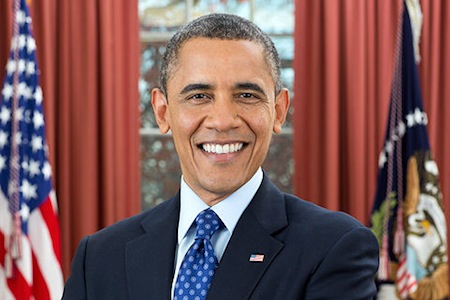
President Barack Obama on December 6, 2012. Credit: Wiki Commons.
Table of Contents
The United States economy was in precarious shape and the American people had grown weary of war. So when the Democratic candidate campaigned repeatedly for “Hope and change,” the people listened. On November 4, 2008, Barack Obama became the first African American elected to the presidency, and the nation anxiously waited to see how this relatively young man would handle the serious issues before him.
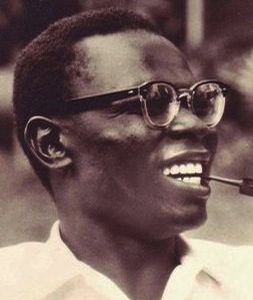
Barack Obama Sr. Credit: Wiki Commons.
Barack Obama’s background was decidedly unique for a president. His mother Ann Dunham had grown up in a middle-class home, the daughter of Stanley and Madelyn Dunham of Kansas. The couple had eloped just before the bombing of Pearl Harbor, and after Stanley’s war service, they returned to Kansas but later moved to Texas, California, and Seattle where Stanley worked in the furniture business. Following Ann’s graduation in Seattle, Stanley learned of a new furniture store opening in Hawaii, and the thought of going there on the eve of its statehood greatly appealed to him. So the three made the move.
Once in Hawaii, Ann began attending the University of Hawaii where the shy eighteen-year-old soon made a friend in the school’s first African student, Barack Obama. The Dunhams had long considered themselves liberal in their attitude towards race. In fact, their grandson later speculated that was their prime reason for leaving Texas, where Ann had been harassed by children for playing with a black girl. Now her parents encouraged Ann to bring home this young man so that they could meet him.
Barack Obama, Sr. was a native of Kenya. Madelyn Dunham later said that one of his attributes had been a “voice like black velvet ... with a British accent.” (1) Obama was a member of the Luo tribe and had grown up on his family’s farm. His academic prowess brought him recognition and opportunity. After attending a school in Nairobi and studying in London, he traveled to the University of Hawaii in 1959 to study econometrics. By this time, he was married and had a wife and child who remained in Kenya. He told Ann of his other family but assured her they were divorced. She later found this to be untrue.
Late in 1960, the couple was married. Then on August 4, 1961, Barack Hussein Obama, Jr. was born. Soon afterward, Barack Sr. received news of a Harvard scholarship. Even though the financial arrangement did not include taking his new family, that didn’t stop Barack Sr. from leaving Hawaii, Ann, and his son behind. Once it became clear that this situation was not temporary, Ann divorced Barack Sr., who ultimately moved to his native Kenya with another American wife who bore him two children.
Ann’s next husband was another foreign student, Lolo Soetoro of Indonesia. In 1967, Lolo, Ann, and her six-year-old son began their life together in his homeland. Barack embraced his new free life of running and playing with other children, but at school there were rules, and misbehavior meant feeling the sting of the teacher’s bamboo stick. He later wrote of his new diet that included dog, snake, and grasshoppers. He also recalled the poverty of the people and the sight of his mother attempting to give money to beggars, only to see that there were always more than she had money. Lolo taught the boy some boxing, but mainly Barack remembered his stepfather’s life lessons: “Men take advantage of weakness in other men. ... Better to be strong. If you can’t be strong, be clever and make peace with someone who’s strong. But always better to be strong yourself. Always.” (2)
A sister, Maya, was born to the family, but by this time, tension began to grow between Ann and Lolo. Obama attended an Islamic school in Indonesia while having daily English lessons with his mother. She also reminded the boy of his African American heritage and shared inspirational stories of Dr. Martin Luther King, Jr. and Thurgood Marshall. Ann grew increasingly worried, however that her son’s future would be seriously impaired the longer he remained away from the United States. By 1971, preparations were made for Barack to return to Hawaii and live with his grandparents. It was time he went home.
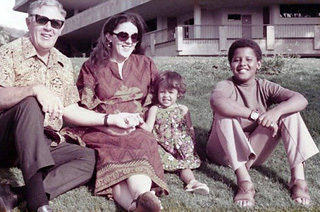
Barack Obama with his grandfather, mother, and half-sister in Hawaii. Credit: Wiki Commons.
In Hawaii, Barack’s grandparents, whom he called “Gramps” and “Toots,” became his surrogate parents. He moved into their apartment and soon found himself enrolled in the prestigious Punahou Academy. Barry, his nickname used by friends and family, at first stood out among the other fifth graders who wore stylish clothes and lived in nice homes. Obama could boast neither. His grandfather struggled to earn a living as an insurance agent while his grandmother had steadily worked her way up the ladder at a local bank from secretary to vice president, the first woman to do so in Honolulu.
Although the ten-year-old Barack was not familiar with American sports like football, he soon learned and made friends. That Christmas, two visitors stayed for a month -- his mother from Indonesia and his father from Africa. Years later, Barack admitted that he did not vividly recall what they said during their time together, just a collection of images remained in his memory. Barack Sr., however, did criticize the grandparents and Ann for not pushing Barry harder and making him study more. It was only near the end of the visit when the two generations of Obama men took time to bridge their gap. Barack Sr. turned on African music and taught his son some tribal dances. It was the only time during Barry’s life that he felt any real connection to his father and it was over all too soon. In an interview decades later, Obama admitted that his personal drive originated from his father, a man who he barely knew but spent years trying to measure up to: “Every man is trying to live up to his father’s expectations or make up for his mistakes. In my case, both things might be true.” (3)
By the time Barack was in high school, his mother had separated from his stepfather Lolo and returned to Hawaii with her daughter Maya. Ann re-enrolled at the University of Hawaii to pursue postgraduate studies in anthropology, and her now teenage son joined them. Barry made satisfactory grades and also enjoyed just lounging on the beach or surfing. He also found himself drawn to basketball, and spent hours at the courts near his grandparents’ apartment or at school. He later admitted that his passion exceeded his skill, yet he spent hours playing. When Ann decided to return to Indonesia to do her fieldwork, she wanted both of her children to accompany her. Obama, however, balked at leaving his free and fun lifestyle behind, so she relented and agreed that he could resume living with his grandparents.
Obama later wrote of his angst in his adolescence growing up biracial and without a father. He began making attempts to come to terms with his racial heritage. He immersed himself in black literature: W.E.B. Dubois, Langston Hughes, and James Baldwin became his nightly companions, rather than the homework that sat unfinished. The work that Barack found the most comfort in was The Autobiography of Malcolm X. Obama later wrote that “[Malcolm’s] repeated acts of self-creation spoke to me; the blunt poetry of his words, his unadorned insistence on respect, promised a new and uncompromising order, martial in its discipline, forged through sheer force of will.” (4)
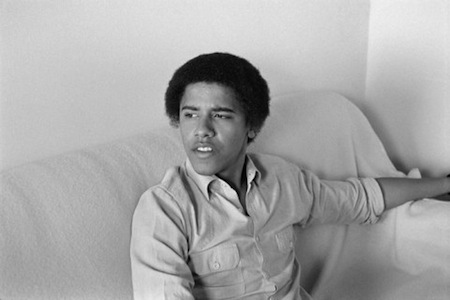
Barack Obama at Occidental College in 1980.
By his senior year, Ann had returned and found her son floundering. His grades had dropped, he was experimenting with drugs, drinking, and smoking, and showed no interest in college or a future. Ann pushed her son to apply to colleges, and ultimately he received a full scholarship to Occidental College in Pasadena, California.
Obama’s freewheeling lifestyle continued in California, and there he met more people with the same interests. He later wrote that he carefully chose his friends and joined leftist political groups in order to avoid being mistaken as a “sellout.” Obama became known for his activism. He pushed to have representatives of the African National Congress visit Occidental and was the first speaker at a rally to protest Occidental’s refusal to oppose South African apartheid. Here, Obama experienced his first thrill giving a political speech.
In 1981, Barack decided to transfer to Columbia University to study political science and international relations. Switching colleges was a transition but the change to the milieu of New York City was amazing to the twenty-year-old. Still, the young man chose to resist much of the allure of the city that never sleeps and instead attended classes and read ravenously. He referred to this period as leading a monk-like existence and initiated a daily fitness routine, which included running several miles. This new emphasis continued, and friends could see a difference in his temperament if he missed a workout.
Obama graduated in 1983 and promptly landed a job with Business International Corporation as a research assistant. His job writing articles for this firm with global connections to American businesses paid the bills and provided him with an opportunity to see his future as an international businessman. The image troubled him, and he continued to tell others of his dream to be a community organizer. He later admitted he was not sure what one did when he left to become one.
The jobs he had as a community organizer in Brooklyn and Harlem were part-time positions and did not pay enough to meet his expenses. Obama’s life changed when he heard from Jerry Kellman, a Chicago community organizer who needed workers to help the city’s extremely poor black population on the South Side. Kellman headed the Developing Communities Project and convinced the young man that he could make a difference. Within a week of his meeting with Kellman, Obama packed and moved to Chicago.
Community Organizing in Chicago
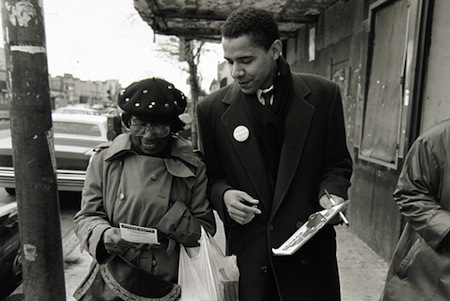
For three years Barack Obama worked tirelessly with the people of Chicago’s South Side, with community leaders, and interdenominational church groups, trying to find ways to bring jobs, stability, money, and power to those who felt most disenfranchised. Little victories happened along the way but were soon wiped out by bigger disappointments. The Altgeld Gardens housing project became Obama’s first assignment. Located near a landfill, factory, and sewage plant, this decrepit housing complex was home to nearly two thousand residents. Obama succeeded in having the Chicago Housing Authority make improvements to the project’s appalling conditions.
Kellman pushed Obama to connect with the people he was there to help. Conducting daily interviews, sitting around a kitchen table and hearing someone’s life story aided the young man understand people in a way he had never known before. Still, major blocks remained to his efforts to help people of the South Side. Schools were deteriorating, and although no one argued otherwise, few were willing to fight it. Obama and others wanted to start a mentoring network for youth. A common theme of fatherless black youth hit a responsive chord with Obama. He tried to help some of the young men he met along the way.
One of Obama’s major disillusions came when he realized that the ministers were unwilling to cooperate because they competed against each other. One of them, Reverend Jeremiah A. Wright of the Trinity United Church of Christ, cautioned him, “You are not going to organize us. That’s not going to happen.” (5) Although his hopes of winning support of the various churches did not materialize, Obama found that he and the Rev. Wright had much in common. After bouncing around church to church without finding one he particularly liked, Obama found a spiritual home at Trinity.
With the death of Harold Washington, Chicago’s first black mayor, in November 1987, Obama’s enthusiasm for community organization waned. He now looked to do something else and believed further work required a law degree. Before heading to law school, though, he decided to take a trip to Kenya and attempt to connect with his African roots.
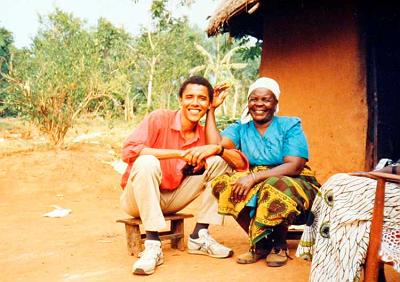
Barack Obama in Africa.
Barack Obama, Sr. had passed away while his son was at Columbia University. Afterwards, Barack was visited by his half-sister, Auma, and encouraged by friends in Chicago to make the pilgrimage to meet his father’s family. For several weeks, Barack met relatives and attempted to learn bits of the Luo (his father’s tribal language). Spending time in Nairobi and traveling to a small village in Kenya where he met more relatives, he encountered a variety of experiences and gained a keener understanding of both his father and himself. On his first day in Africa, his Auntie Zeituni told his half-sister Auma to make sure he did not get lost again. Unsure what this meant, Barack asked Auma, and she explained that it was an expression used for either a person who had not been around for a while or one who left and eventually forgot his family and roots. Its meaning for him remained ambiguous.
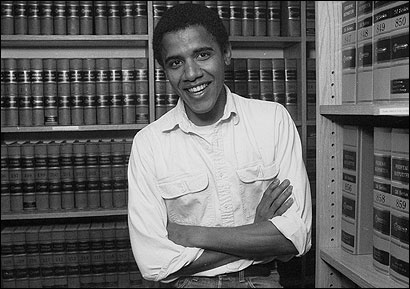
Barack Obama at Harvard Law School.
Now with some questions answered, Obama returned to the United States to begin his studies at Harvard Law School. For the next three years, Barack dedicated himself to the study of law. He stood out among the incoming first-year students since he was twenty-seven years old and had already toiled as a community organizer for the past three years. His life experiences provided him with a grounding and maturity which aided him. One classmate, Cassandra Butts, later remarked about how “he came to discussions with much more life experience than most of the students.” (6)
Although he did indeed spend many an hour studying in the library, Obama also found time to make friends and liaisons. He joined the Black Law Students Association and served on its board of directors as well as spoke at various functions. Obama often wove in the theme of using their exceptional education to give back to their communities. This belief came to the forefront when he participated in a debate among the African American population of Harvard’s professional schools. What should they call themselves: black or African American? After hearing the different opinions, Obama cut through the rhetoric: “You know, whether we’re called black or African Americans doesn’t make a whole heck of a lot of difference to the lives of people who are working hard, you know, living day to day, in Chicago, in New York. That’s not what’s going to make a difference in their lives. It’s how we use our education in these next three years to make their lives better. You know, that’s what’s going to have an impact on making the U.S. a more just place to live, and that’s what’s going to have an impact on their lives.” (7)
Obama’s grades, writing, and popularity among staff and students won him a place on the staff of the prestigious Harvard Law Review. Serving on this staff adds quite a cachet to any resume but to become its president is akin to being handed the keys to the kingdom. The president is elected from the Review’s staff of students, and at first Obama expressed that he would not run. While most staffers planned to acquire a clerkship with a federal judge or become a member of a law school faculty, he knew that his future did not rest on winning this post. Helping Chicago’s South Side population did not require this, but after friends urged him to reconsider, Obama ran. Voting all day, the staff gradually weeded out the field to two. One was Obama. After assurances that no position would be kept from the Review’s pages, conservative students threw in their support, and Barack Obama became the first black editor in the Review’s 103-year history.
Obama’s election immediately made headlines. Obama explained his feelings to a reporter for the Los Angeles Times in March 1990: “For every one of me, there are thousands of young black kids with the same energies, enthusiasm and talent that I have who have not gotten the opportunity because of crime, drugs and poverty. I think my election does symbolize progress but I don’t want people to forget that there is still a lot of work to be done.” (8)
Not all were pleased. Some black students complained that Obama did not fill as many staff slots as he could have with minorities. Race relations were particularly strained at Harvard during this time, because its only tenured African American professor, Derek Bell, took a leave-without-pay to protest the unwillingness of administration to hire other black professors. Some more left-leaning staff members also expressed concerns about the number of students from the conservative Federalist Society whom Obama gave positions to.
Treading through this minefield, Obama showed a willingness to work with everyone. People later noted that because he could so easily converse with both sides, one often had no idea what his true feelings were. One of his professors, Charles J. Ogletree Jr., said, “He can enter your space and organize your thoughts without necessarily revealing his own concerns and conflicts.” (9) Obama’s editorship might not have been as rigorous as some would have preferred, so the next year, the staff chose “a tougher editor” and “someone who would be a more rigorous blue-penciler.” (10)
Obama’s time spent coordinating quarreling factions at the Review provided him with an experience that proved beneficial in his later political career. But for now, he looked to returning to his community involvement in Chicago as well as resuming his courtship of attorney Michelle Robinson.

Barack and Michelle Obama at their wedding.
Obama had met Michelle in the summer of 1989 after his first year at Harvard. He was an intern at the corporate law firm of Sidley Austin, where Michelle was an attorney assigned to be his mentor. Many tried to talk him up to her, but she later stated that she had misgivings about “this good-looking, smooth-talking guy,” since he was her trainee and she worried that it would “look pretty tacky” (11) to date the only other black on the staff. Barack, however, refused to be deterred.
Michelle was born in 1964 to a middle-class family from Chicago’s South Side. She had excelled in sports and academics, later attending Princeton University and Harvard Law School. Once the couple was engaged, Michelle decided to alter her career path and joined Mayor Richard Daley’s staff. After finishing at Harvard, Obama put his legal career on hold while he directed Illinois Project Vote, an effort to register Chicago’s black population for the 1992 presidential election. His efforts helped ensure victory in Illinois for President Bill Clinton, as well as the historic election of Carol Moseley Braun, the first black woman senator. Obama also had the task of writing his memoir. In between everything else, Barack and Michelle married on October 18, 1992 at Rev. Wright’s Trinity United Church of Christ.
The following year, Michelle joined with AmeriCorps to start Chicago’s office of Public Allies. Here she worked tirelessly for three years to establish a firm foundation for this agency devoted to putting unemployed young people to work. Her tenure was hailed as a tremendous success. She followed this with a stint at the University of Chicago as associate dean of student services and later as director of community affairs for the University of Chicago Hospitals.
After getting married, the Obamas settled into the Hyde Park neighborhood. In 1998, they welcomed their first daughter, Malia; three years later, their second daughter Sasha was born. By this time, Obama’s political career was starting, and Michelle had a new role -- political wife.
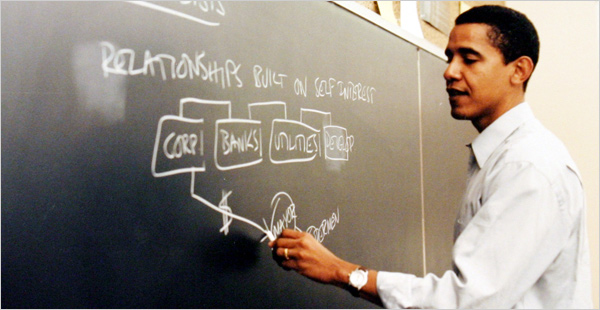
Barack Obama teaching at the University of Chicago. Credit: Obama for America.
Following the 1992 election, Obama began a two-pronged legal career -- teaching constitutional law part-time at the University of Chicago and taking a job with the Chicago civil rights firm of Miner, Barnhill & Galland. Although he never tried a case himself, he assisted other attorneys who represented a variety of clients with discrimination suits. One of these suits was against the state of Illinois, charging it with failure to follow federal laws in allowing voter registration of the poor. Obama also represented black voters of Chicago who successfully sued that they had been discriminated against when new ward boundaries for the city had been drawn after the 1990 census. Through his work at the firm and close association with Judson Miner, who had been counsel in Mayor Washington’s administration, Obama gained key political contacts that would assist him when he decided to make the dive into that arena. After a few years of practicing law, Obama decided that working for change through the courts was entirely too slow of a process; instead, he determined the best way to seek reform was through running for office.
Obama saw his first opportunity to enter politics when State Senator Alice Palmer announced she was running for Congress and made clear that he had her blessing to campaign for her seat. Obama filed for candidacy in August 1995, just one month after his memoir, Dreams from My Father, was published. Palmer, in fact, had selected him as her successor and revealed this at a meeting of another Hyde Park resident, William Ayers, professor and well-known radical of the 1960s. The two candidates’ friendship grew cold, however, when Palmer’s congressional campaign slumped, and she told Obama that she wanted to resume running for her state senate seat.
By now, Obama had a strong organization helping him and believed he had a good chance to win, so he refused to relinquish his candidacy. In a move that showed the idealistic candidate’s grasp of hardball politics, Obama challenged Palmer’s candidacy on technical grounds, saying that she hadn’t garnered enough signatures in the right amount of time. Palmer was blocked from running and the other Democratic challengers also quit, so Barack Obama ran as the sole candidate for his party in the primary. In such an overwhelmingly Democratic district, this equated to an easy victory in November 1996. The thirty-four-year old had successfully begun his political career.

Illinois State Senate official photograph.
After arriving in Springfield, Obama found himself an outsider looking in. First, the Republican Party had the majority in the state senate. Second, other black senators did not provide a warm welcome for the freshman senator. Bad feelings remained about his unwillingness to drop from the race and allow fellow African American Alice Palmer to be re-elected; nor did the press find him particularly ingratiating. Knowing he would need some help to understand the world of state politics, Obama began working with aide Dan Shomon, a Springfield veteran who proved a useful sounding board. Shomon took Obama on an illustrative road trip through southern Illinois to show him how to connect with conservative rural voters who were traditionally suspicious of Chicago politicians. It was the kind of bridge-building exercise that would be essential if Obama ever hoped to run for higher office.
At first, Obama failed to make much headway. Realizing that he had to would have to switch gears in order to be successful as a lawmaker, the mild-mannered, intellectual Obama changed, learning golf and joining in a weekly poker game with fellow legislators.
Emil Jones, Jr., the senate’s Democratic leader, also from the South Side, chose the freshman Obama to push through campaign reform legislation. This was Obama’s first major task, and he scored a major win with a 52-4 vote. Other bills that Obama co-sponsored during his first years included compensation of crime victims for property losses, working to help hospitals deal with sexual assault cases, investigation into nursing home abuses, and increasing funding for after-school programs. He became known for working with Republicans to pass legislation. Obama described his willingness to “bring all sides of an issue to the table and you make them feel they are being listened to.” (12)
Aching to make a difference on the national level, in 1999, Obama decided to run against the popular incumbent and former Black Panther Bobby Rush in the Democratic primary for U.S. Congress. Again, Obama was criticized for trying to unseat another black politician. Then some began questioning his “blackness,” pointing to his biracial heritage, Hawaii upbringing, and attending predominantly white colleges. It was an easy victory for Rush. Obama later wrote of his difficulty continuing with the campaign after realizing halfway through that he was going to lose. He explained, “The politician’s loss is on public display. ... it’s impossible not to feel ... as if you have been repudiated by the entire community, that you don’t have what it takes, and that everywhere you go the word ‘loser’ is flashing through people’s minds.” (13)
Returning to Springfield, Obama resumed his legislative work and attempted to gain more political support from his Democratic colleagues. He chaired the committee on Health and Human Services and served on others including Education and Welfare. He championed abortion rights and supported stem cell research. In other legislation, he backed unions and favored imposing a use tax for natural gas and restoring the estate tax to Illinois.
Still, Obama felt frustrated. He sought office on a higher level. Looking ahead to 2004, he spied an opportunity in the U.S. Senate seat of Republican incumbent Peter Fitzgerald. Although many pledged support, they also cautioned him not to run, warning that he would likely lose and put a great strain on his family in the process. Nevertheless, Obama viewed this as his final opportunity and seized it. Friends began making inquiries, and slowly a financial base of support in Chicago made a Senate run viable.
In the fall of 2002, before formally announcing his Senate candidacy, Obama spoke to an antiwar rally in Chicago. He told them he was not totally opposed to war but was opposed to the impending invasion of Iraq, calling it “a dumb war” that was “based not on reason but on passion, not on principle but on politics.” (14) He later admitted that although “it was a hard speech to give,” (15) it was also the speech he was proudest of.
Emil Jones, Jr., now president of the Illinois Senate, agreed to help Obama strengthen his legislative credentials. Legislation was given him to guide through the ssenate that would help his profile; likewise, Jones kept Obama’s campaign schedule in mind to ensure that key votes did not occur while he was gone. (Obama’s voting record in the Illinois senate would later be questioned when it was learned that he voted “present” 130 times, when he did not wish to be on the record voting for/against a controversial issue such as abortion, which could trouble voters in later campaigns.) (16)
When the primary campaign began, the frontrunner was at first Don Hynes, whose father had a history in Chicago politics and who also originally had strong union backing. However, once Obama’s pro-labor state legislation demonstrated an active willingness to work for their cause, unions such as the Service Employees Union International endorsed the relatively unknown candidate. Other unions soon followed. Opponent Gery Chico excelled at providing the pithy sound bites that audiences tended to prefer to the longer speeches that Obama was prone to give. In fact, Obama worked to improve his public speaking skills by studying African American ministers and imitating their cadence and rhythm. David Axelrod, Obama’s media consultant, devised a campaign theme of “Yes, we can,” with commercials pledging change in Washington if Barack Obama was elected. The voters believed, and he handily won the primary with 53 percent of the vote. Now it remained to be seen if he could win a general election against the Republican incumbent Jack Ryan.
Ryan had served in the Illinois legislature with Obama, and he, too, had the good looks to help his candidacy. But not long before the general election, Ryan found himself awash in scandal. In the summer of 2004, newspapers successfully sued to open Ryan’s sealed divorce records., The resulting revelations about Ryan’s aberrant sex practices (which included pushing his then-wife, actress Jeri Ryan, to accompany him to sex clubs) caused him to drop out of the race. While the Republican Party frantically cast about for a replacement, an increasingly popular Barack Obama was selected as the keynote speaker at the 2004 Democratic convention.
Few senatorial candidates are provided as rich an opportunity as awaited Barack Obama on July 27, 2004 when he addressed the crowd at Boston’s Fleet Center arena and the millions watching at home. In a speech that called for an end to the electorate’s increasing polarization, he told the audience, “there’s not a liberal America and a conservative America; there’s the United States of America. There’s not a black America and white America and Latino America and Asian America; there’s the United States of America.” He went on to quote from Dr. Martin Luther King, Jr., saying that his belief in “the audacity of hope” also included “the hope of a skinny kid with a funny name who believes that America has a place for him, too.” (17) His speech received rave reviews and pushed Obama into a higher strata of political achievement.
Now, candidate Obama drew huge crowds wherever he went. Sometimes all of the adulation and attention became overwhelming for both he and Michelle. By August, Republicans had drafted black conservative (and non-Illinois resident) Alan Keyes to oppose Obama. The tidal wave of popularity was too much for the last-minute rival to fight. Obama won the senate seat by a historic margin of 70 to 29 percent.
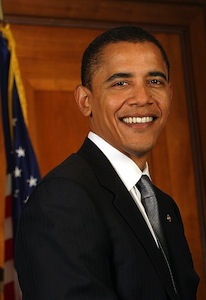
2005 portrait of Barack Obama as junior senator from Illinois.
On January 4, 2005, Michelle and daughters Sasha and Malia watched proudly as Barack was sworn in as a U.S. senator. Afterwards the family posed for pictures and six-year-old Malia asked, “Daddy, are you going to be president?” (18) Others were asking the same question, and the next day, Obama told reporters that he was not planning to run for president in 2008. Instead, he found his life quite full as he learned to negotiate the turns and pitfalls of life in the capital city.
Obama gained a seat on the Foreign Relations committee an